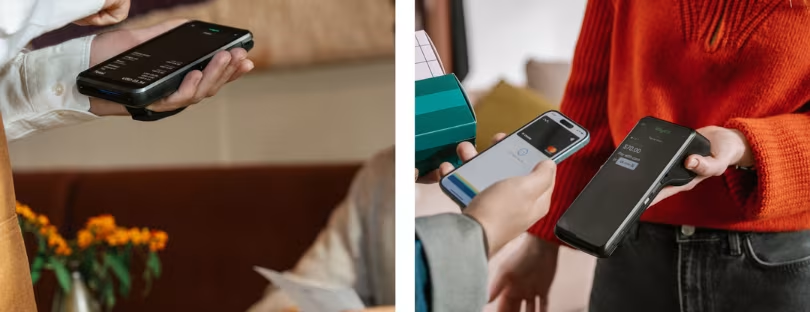
Adyen raises the bar with two next-gen payment terminals
In the fast-moving world of in-person payments, Adyen has just delivered a meaningful upgrade. The Amsterdam-based fintech today announced the launch of two new terminals—the S1E4 Pro and S1F4 Pro—designed to tackle the real-world challenges of retail, food & beverage (F&B), hospitality and beauty/wellness environments.
From my vantage point covering travel tech and payments, this is more than a product refresh—it’s a clear signal that Adyen intends to deepen its footprint in the physical, on-the-floor world of payments, complementing its strong digital-commerce heritage.
S1E4 Pro: built tough for service environments
The S1E4 Pro is an all-in-one mobile POS device, purpose-built for high-stress, high-volume settings like restaurants, bars, event venues and hospitality services. According to Adyen, it’s rated IP-65 (spill- and dust-proof) and drop-proof up to 1.5 m—no small feat for a payment terminal.
Other highlights:
- A 6.1-inch screen for excellent visibility even in dynamic settings.
- A hand strap for rugged floor use (think: servers taking payments at tables).
- Certified for PCI-6 and “PCI-7 ready” (i.e., ready for next-generation standards).
- Connectivity via 4G and WiFi, a fast processor, and all-day battery life—reflecting the expectation of nonstop service.
- Supports tap, insert, swipe, QR code payments, and multiple currencies.
- Runs Android 13, allowing merchants to integrate their existing business apps for ordering, payments, and back-office tasks all on one device.
For a restaurant or venue where downtime is disastrous (a broken terminal means waiting customers, annoyed staff, and lost sales), the S1E4 Pro is trying to remove that risk.
S1F4 Pro: mobility + printing fused
On the other side of the coin is the S1F4 Pro, which mixes portability with built-in printing and a full suite of connectivity options — making it ideal for retail-floor environments where you might want a countertop POS one minute and a mobile checkout the next.
Key features:
- 6.7-inch screen for larger form-factor experience.
- Integrated printer: useful for receipts, tickets or confirmations without a separate device.
- Docked-countertop mode + mobile mode for flexibility.
- Connectivity: 4G, WiFi, Ethernet. Runs Android 13.
- Front and rear cameras + QR-code scanner—good support for loyalty, identity or scanning workflows.
- Same PCI-6 certified / PCI-7 ready, Octa-core processor, long battery life—durability and performance baked in.
In retail, where “queue busting” is a key metric (minimising customer wait and improving throughput), a mobile terminal that can print on-the-spot is a strong value proposition.
Why these launches matter now
It’s worth stepping back and asking: why is Adyen investing in rugged, mobile terminals now? Here are three contextual drivers:
- In-store payments remain a growth frontier. While digital and e-commerce continue to grow, the physical store remains vital — and the payment experience is increasingly a competitive differentiator. For example, Adyen’s own insight: “the payment experience is a dealbreaker” in retail.
- Mobile POS and portable terminals are rising. Markets like Australia identify “mobile in-store POS terminals” as a key trend for 2024 — shifting away from fixed checkout desks.
- Merchants want unified commerce and fewer point-of-pain devices. If ordering, payment, loyalty and back-office live on the same device, operations are simpler and more efficient. Adyen’s press release emphasises this: the new terminals were developed by “listening closely to our customers … tailored to the operational demands of a whole range of verticals.”
In short, these terminals aren’t just incremental — they reflect Adyen’s strategic push to go deeper into the “in-person” layer of commerce, and support the service-heavy sectors (F&B, hospitality, retail) where speed, reliability and mobile flexibility matter most.
Market positioning, competition and what it means
From a competitive lens: how does Adyen’s move stack up? Players like Stripe, Worldline and others are all active in the in-person payments arena. For example, Stripe has emphasised its Terminal product, while Worldline emphasises local acquiring and terminal hardware. Adyen’s differentiator here appears to be the blend of hardware resilience, mobile flexibility, global payments stack and merchant app ecosystem via Android 13.
That said, risks and challenges remain: hardware rollout involves logistics, support, replacement cycles, firmware updates and security lifecycle management. Also, smaller merchants or niche verticals may prefer plug-and-play soft-POS or tablet-based payments rather than heavy duty terminals.
In the broader context of payment trends, Adyen’s own research across APAC identifies portable in-store payment terminals and mobile device-based payments as major priorities. Thus this launch aligns strongly with the macro-direction of the industry.
Final thoughts: implications for merchants and the travel/tech space
For merchants — especially those in travel-adjacent or hospitality-intensive sectors (restaurants in airports, hotel bars, cruise ship boutiques) — the S1E4 and S1F4 Pro offer tangible advantages: less downtime, faster check-out, more flexible check-out, stronger durability. That’s meaningful when guest experience and throughput matter.
From a travel tech/media platform perspective (and with your focus on connectivity, roaming, tech solutions) this also signals something broader: payment hardware is converging with smart device platforms (Android), connectivity (4G/5G/WiFi), multi-currency support and ubiquitous payment methods (tap, QR, wallet). You could argue that the terminal itself is now a connected device — almost like an IoT endpoint in the ecosystem of the venue.
Another lens: for your audience—frequent travellers & digital nomads—when you stay at a hotel or use an F&B venue that uses a device built for “rigorous, high-volume” service, the friction is low. It all just works. That’s part of the value chain of hospitality tech that often goes unnoticed.
In conclusion
Adyen’s twin terminal launch is more than hardware—it’s a strategic reinforcement of the company’s in-person payments ambition. With the S1E4 Pro and S1F4 Pro, Adyen is signalling that in-store, on-the-floor payments deserve the same innovation, flexibility, and global scale that e-commerce has enjoyed. For merchants across retail, hospitality and beauty/wellness sectors, the ability to deploy rugged, mobile, multifunction devices isn’t just nice-to-have—it can directly impact service efficiency, customer satisfaction, and ultimately, revenue. As the payment landscape keeps shifting toward mobility, seamless omnichannel experiences and global scale, Adyen’s hardware move positions it strongly—but it will need to execute on deployment, support, and merchant delight to make the promise real.











